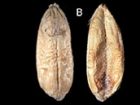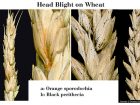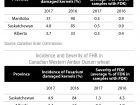
Features
Agronomy
Diseases
A Fusarium head blight lesson
It was the best of times and the worst of times. The year of 2016 was certainly one of the worst of times for Fusarium head blight (FHB). High FHB incidence and severity was widespread across the Prairies, with durum wheat hit especially hard. By contrast, 2017 saw much lower levels of FHB across the Prairies. The difference?
May 15, 2018 By Bruce Barker
 Durum wheat suffered badly from Fusarium in 2016. Photo A: Sound; Photo B: Moderate symptoms of FDK It was the best of times and the worst of times.
Durum wheat suffered badly from Fusarium in 2016. Photo A: Sound; Photo B: Moderate symptoms of FDK It was the best of times and the worst of times.“Dry and warm conditions really helped limit Fusarium head blight development across the Prairies in 2017,” says Kelly Turkington, an Agriculture and Agri-Food Canada (AAFC) pathologist in Lacombe, Alta.
Information from the Canadian Grain Commission’s annual harvest sample program illustrates the difference weather can make on FHB incidence and severity. Comparisons between 2016 and 2017 show greatly reduced FHB in 2017.
For comparisons of incidence and severity by provincial crop district going back to 2003, go to the Canadian Grain Commission website for more detailed data on red spring wheat and durum wheat samples. (www.grainscanada.gc.ca/str-rst/fusarium/data/fdkmenu-en.htm)
The percentage of FDK is an important grading factor in wheat. In 2016, the average CWRS wheat sample submitted to the CGC would have graded a No. 3 in Manitoba and Saskatchewan and No. 2 in Alberta. Durum would have graded Sample in Saskatchewan and No. 3 in Alberta.
The difference in disease levels between 2016 and 2017 is a textbook example of the disease triangle. For a disease to develop, there needs to be a susceptible host, a favourable environment and sufficient quantities of a virulent pathogen, when combined can result in the development of a disease. In 2017, taking away the favourable environment resulted in greatly reduced FHB levels.
Management practices for 2018
The one factor farmers can’t control is the weather. The exception is irrigated crops where limiting irrigation just prior to and during the heading period may help to lower FHB. For dryland production, pathologists recommend that farmers focus on the other two aspects of the disease triangle – susceptible host and the pathogen.
For wheat growers, selecting a variety with FHB-resistance is the first step in helping to manage the disease. CWRS wheat growers have a fair number of varieties available with a Moderately Resistant (MR) rating. A few MR varieties are available in the CPSR and CWSP wheat classes. In the CPSR class, AAC Tenacious VB is rated as Resistant to FHB. Similarly in the CWRW winter wheat class, Emerson is rated as Resistant. In the other wheat classes, including durum, the best resistance rating is Intermediate, which can still offer some reduction in FHB under lower disease levels, and may help improve fungicide control.
The impact of selecting the best resistance package was illustrated in research done by AAFC and the University of Manitoba. Field trials were conducted under natural infection and artificial inoculation from 2012 to 2014 at seven sites across the Prairies. The researchers looked at four wheat varieties with different resistant ratings, and the impact of seed treatment and foliar fungicide application on FHB and yield.
In the research, Anita Brûlé-Babel and Zesong Ye of the University of Manitoba, and colleagues from AAFC including Rob Graf, Rob Mohr and Brian Beres found that under higher FHB pressure, Carberry CWRS and Emerson CWRW had superior FHB resistance with reduced FDK and DON levels and higher yield. Carberry is rated Moderately Resistant and Emerson is rated as Resistant. The susceptible varieties Harvest (moving to CNHR wheat class on August 1, 2018) and the CWSP variety CDC Falcon had higher levels of FDK and DON.
Additionally, winter wheat had overall higher yields with Emerson yielding the highest and most stable across environments. Winter wheat matures earlier than spring wheat, and may have grown past the infectious flowering stage when Fusarium infections occur
Seed treatment alone did not reduce the impact of FHB. However, it did increase winter wheat stand establishment and overwinter survival. Test weight was higher for both winter wheat varieties, and seed treatment increased kernel weight in Emerson. While Fusarium-infected seed does not directly correlate to FHB, using good quality seed that has been treated with a seed treatment produces a uniform crop stand that helps with fungicide timing application.
Foliar fungicide application and crop rotation are factors that farmers can control to help manage the pathogen in the disease triangle. In Brûlé-Babel’s research, foliar fungicide application, with or without a seed treatment, generally produced higher yields with greater stability, especially with more susceptible varieties when FHB pressure was high.
In other University of Manitoba research in 2011, Brûlé-Babel says that foliar fungicide application was more effective in reducing FHB, FDK and DON levels with moderately resistant varieties, while the response to fungicide application in susceptible varieties was much less. She says that farmers should first spend money on the best FHB-resistant varieties, even if they are going to spray a fungicide.
Crop rotation can also manage the FHB pathogen. The pathogen can survive on crop residues of corn and small-grain cereals such as wheat and barley.
“From a pathologist perspective, a two year canola/cereal rotation that is common on the Prairies is simply not long enough for decomposition of any crop residues that may be carrying residue-borne diseases like cereal leaf spots and Fusarium head blight,” Turkington says. “It is simply not enough time.”
Crop rotation should have at least a two-year break in cereals and corn to help reduce pathogen survival. Additionally, avoid planting cereals adjacent to fields that had significant FHB infection in the previous year.
Predictions for 2018
Projecting what FHB levels in 2018 goes back to the disease triangle. What happened in 2016 provides clues for how the disease may progress in 2018. For farmers in a two-year rotation of canola-wheat, the 2018 FHB potential is serious. A wheat field that was heavily infected with FHB in 2016 will have a heavy pathogen load going into 2018. Seeding that field back to wheat or another susceptible cereal crop in 2018, even after a one-year break with canola or pulses, will have an elevated risk for FHB.
“The heavy disease load in 2016 will have survived on crop residue. So what happened in 2016 will give you an idea of what might potentially happen in 2018, if weather conditions favour Fusarium head blight,” Turkington says.


